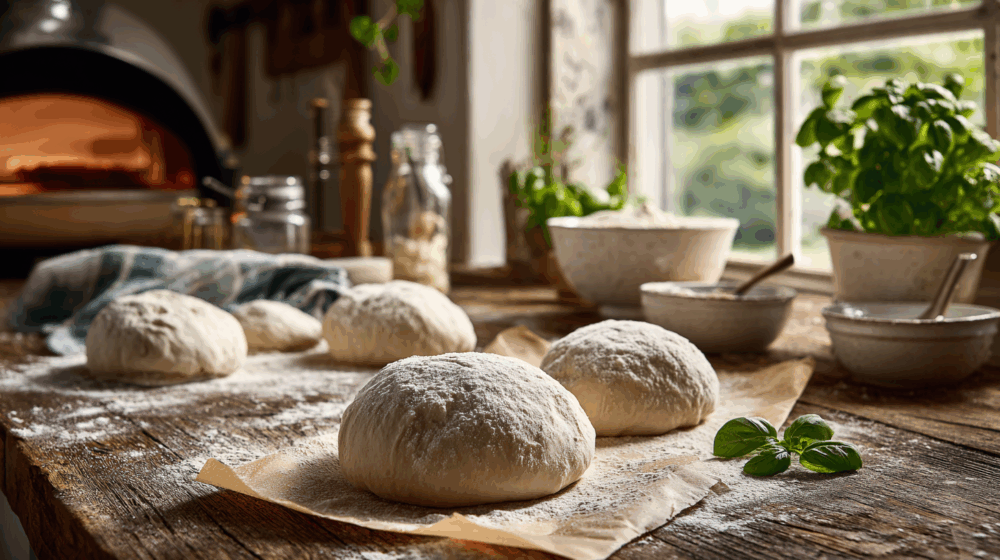
Ingredients
- 607 grams 4¼ cups 00 flour, plus extra for dusting
- 364 grams 1½ cups lukewarm water
- 18 grams 4 teaspoons fine sea salt
- 9.2 grams 3¼ teaspoons active dry yeast OR 7 grams (2½ teaspoons) instant yeast OR 20 grams (2 tablespoons) fresh yeast
- Extra flour for dusting
- Semolina flour or cornmeal for pizza peel
Instructions
- Place two-thirds of the water in a large mixing bowl. Heat the remaining third of water until just boiling, then add it to the cold water. This creates the perfect temperature for activating yeast. Whisk the salt and yeast into the warm water mixture until completely dissolved.
- Place the flour in a large bowl and create a well in the center. Pour the yeast mixture into the flour well. Using a wooden spoon, stir from the center outward until a shaggy dough begins to form. Continue mixing until all flour is incorporated and the dough comes together.
- Turn the dough onto a lightly floured surface. Knead by hand for 10 minutes, pushing the dough away with the heel of your palm, folding it back, and rotating. The dough should become smooth, elastic, and slightly tacky but not sticky. Alternatively, use a stand mixer with dough hook for 8 minutes on medium-low speed.
- Shape the dough into a smooth ball and place in a lightly oiled bowl. Cover tightly with plastic wrap or a damp cloth. Let rise in a warm place for 2 hours, or until doubled in size.
- Gently turn the dough onto a lightly floured surface. Divide into 4 equal portions for 12-inch pizzas or 3 portions for 16-inch pizzas. Shape each piece into a tight ball by folding the edges underneath. Place on a floured surface or in separate containers.
- Cover the dough balls with damp cloth or plastic wrap. Let rise for 30-60 minutes at room temperature until doubled in size. For enhanced flavor, refrigerate for 24-72 hours for cold fermentation.
- If dough was refrigerated, remove and let come to room temperature for 30 minutes before stretching. Dust work surface and pizza peel with flour and semolina.
- Starting from the center, gently press the dough outward with your fingertips, leaving a thicker border for the crust. Lift the dough and gently stretch over your knuckles, rotating to maintain a circular shape. Stretch to 10-12 inches in diameter.
- Transfer stretched dough to prepared pizza peel. Add toppings quickly but sparingly. Slide into preheated Ooni oven (850-950°F). Bake for 60-90 seconds, rotating once halfway through for even cooking.
There’s something absolutely incredible about making pizza dough from scratch for your Ooni oven. I remember the first time I successfully stretched that perfect circle of dough – watching it transform in the blazing heat into something that rivaled the best pizzerias I’d ever visited. After countless batches and plenty of trial and error, I’ve perfected this recipe that consistently delivers that authentic Neapolitan experience right in my backyard.
What makes this dough special isn’t just the ingredients – it’s understanding how they work together in the extreme heat of a wood-fired oven. The 60% hydration ratio creates the perfect balance: enough moisture to develop those beautiful air bubbles and charred leopard spots, but not so much that your dough becomes unmanageable or sticks to everything in sight.
I’ve learned that patience is absolutely crucial with this recipe. Yes, you can use the dough after just a few hours, but the magic really happens when you let it cold-ferment in the refrigerator for a day or two. The slow fermentation develops complex flavors that you simply can’t achieve with a quick rise. That subtle tang and nutty undertone you taste in great pizza dough? That’s time working its magic.
The technique of mixing hot and cold water might seem unnecessary, but it’s actually brilliant. This method ensures your water temperature is perfect for yeast activation without any guesswork or thermometer readings. Too hot, and you’ll kill the yeast. Too cold, and it won’t activate properly. This simple trick eliminates that worry entirely.
I’ve made this recipe with both 00 flour and all-purpose flour, and while 00 flour definitely produces superior results, don’t let the lack of specialty flour stop you from making great pizza. The key is in the technique and timing. When I’m stretching the dough, I always start from the center and work outward, letting gravity do most of the work. Fighting with the dough never ends well – if it’s resisting, I just let it rest a few more minutes.
One mistake I made early on was overloading my pizzas with toppings. In a 900-degree oven, less is absolutely more. The intense heat cooks everything so quickly that heavy toppings can weigh down the dough and prevent proper cooking. I stick to simple combinations now – maybe just San Marzano tomatoes, fresh mozzarella, and basil, or a simple white pizza with ricotta and herbs.
The learning curve with pizza ovens is real, but it’s also part of the fun. Every pizza teaches you something new about heat management, timing, and technique. I’ve burned my share of pizzas, had dough stick to peels, and created some truly questionable combinations. But that’s all part of the journey to pizza mastery.
What I love most about this recipe is its forgiving nature once you understand the basics. You can make the dough days ahead, portion it out, and freeze individual balls for future pizza nights. Having homemade dough ready to go makes spontaneous pizza dinners incredibly easy.
The smell alone makes this recipe worthwhile. When that dough hits the hot stone and begins to puff and char, the aroma is intoxicating. It’s yeasty and slightly smoky, with hints of that beautiful browning happening on the edges. My neighbors have definitely been drawn over by that smell more than once.
I’ve also discovered that this dough works beautifully for more than just pizza. I’ve used it for focaccia, flatbreads, and even calzones. The high-heat characteristics that make it perfect for pizza ovens also create wonderful results when you want to experiment with different shapes and preparations.
The timing aspect becomes second nature after a few attempts. Two hours for the initial rise, then either immediate use or refrigeration for enhanced flavor. When you’re ready to cook, just thirty minutes to come to room temperature, a few minutes to stretch and top, and then that magical minute and a half in the oven.
Storage is straightforward too. The shaped dough balls keep beautifully in the refrigerator for up to five days, or in the freezer for three months. I often make double batches and freeze half for busy weeknights when I want fresh pizza without any advance planning.
This recipe has become such a staple in our household that I barely need to reference measurements anymore. The dough should feel slightly tacky but not sticky, with a smooth surface that springs back when gently poked. These tactile cues become your guide once you’ve made it a few times.
The final result is everything you want in pizza dough: a crispy, charred exterior that gives way to a chewy, airy interior. Those signature air bubbles and leopard spots that mark authentic Neapolitan pizza. The kind of crust that’s sturdy enough to hold toppings but tender enough to fold in half for that perfect pizza experience.




